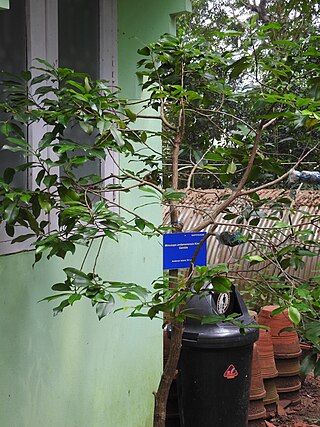Afrocarpus dawei is a species of conifer in the family Podocarpaceae. It is native to Africa, where it occurs in the Democratic Republic of the Congo, Tanzania, and Uganda.

The Ouvea parakeet or Uvea parakeet, is a species of parrot in the genus Eunymphicus, in the family Psittaculidae. It is endemic to the island of Uvea in the Loyalty Islands, New Caledonia. The species was once considered conspecific with the horned parakeet of Grande Terre, but they have now been split into two species.
Manilkara elata, also called the cow tree, is a species of plant in the family Sapotaceae. It is Endemic to the Amazon region in Brazil, where it is endangered by habitat loss.
Manilkara excelsa is a species of plant in the family Sapotaceae. It is endemic to Brazil, and threatened by habitat loss.
Manilkara excisa is an endangered species of tall tree in the sapodilla family. It is endemic to the extremely steep, forested limestone hills of Trelawny, Cockpit Country and St. James parishes in Jamaica, where, although it is highly prized for its wood, it is threatened by habitat loss.
Manilkara gonavensis is a tree species in the sapodilla family endemic to Haiti's Gonâve Island that is considered to be possibly extinct.

Manilkara longifolia, commonly known as masseranduba, is a species of plant in the family Sapotaceae. It is endemic to Brazil, where it is threatened by habitat loss.
Manilkara mayarensis is a plant species in the family of sapodillas, which grows wild only in Cuba's Oriente Province. Here its members range in scale from shrubs to small trees. Its usual haunts are along creeks, ravines and other naturally formed watercourses within its montane, serpentine shrubwood habitat.
Manilkara paraensis is a species of plant in the family Sapotaceae. It is endemic to Brazil, where it is threatened by habitat loss.
Manilkara pleeana, the zapote de costa, is a species of plant in the family Sapotaceae. It is endemic to Puerto Rico.
Manilkara rufula is a species of tree in the Sapodilla family. It is endemic to the northeastern submontane forests of Bahia, Sergipe, Pernambuco, Paraíba, Ceará and Piauí states of Brazil. Although this species exists in many places, where it occurs it is either not numerous, or its numbers are declining due to loss of habitat.
Manilkara spectabilis is an uncommon species of tree in the sapodilla family.
Manilkara subsericea is a species of plant in the family Sapotaceae. It is endemic to Brazil, and threatened by habitat loss.
Mimusops acutifolia is a species of plant in the family Sapotaceae. It is endemic to Tanzania.

Mimusops is a genus of plants in the family Sapotaceae described as a genus by Linnaeus in 1753.
Mimusops penduliflora is a species of plant in the family Sapotaceae. It is endemic to Tanzania.
Mimusops riparia is a species of plant in the family Sapotaceae. It is found in Kenya and Tanzania.

Mimusops sechellarum is a species of plant in the family Sapotaceae. It is endemic to Seychelles.

Mimusops elengi is a medium-sized evergreen tree found in tropical forests in South Asia, Southeast Asia and northern Australia. English common names include Spanish cherry, medlar, and bullet wood. Its timber is valuable, the fruit is edible, and it is used in traditional medicine. As the trees give thick shade and flowers emit fragrance, it is a prized collection of gardens.

Mimusops andamanensis is a species of plant in the family Sapotaceae. It is native to Sri Lanka and the Andaman Islands.






